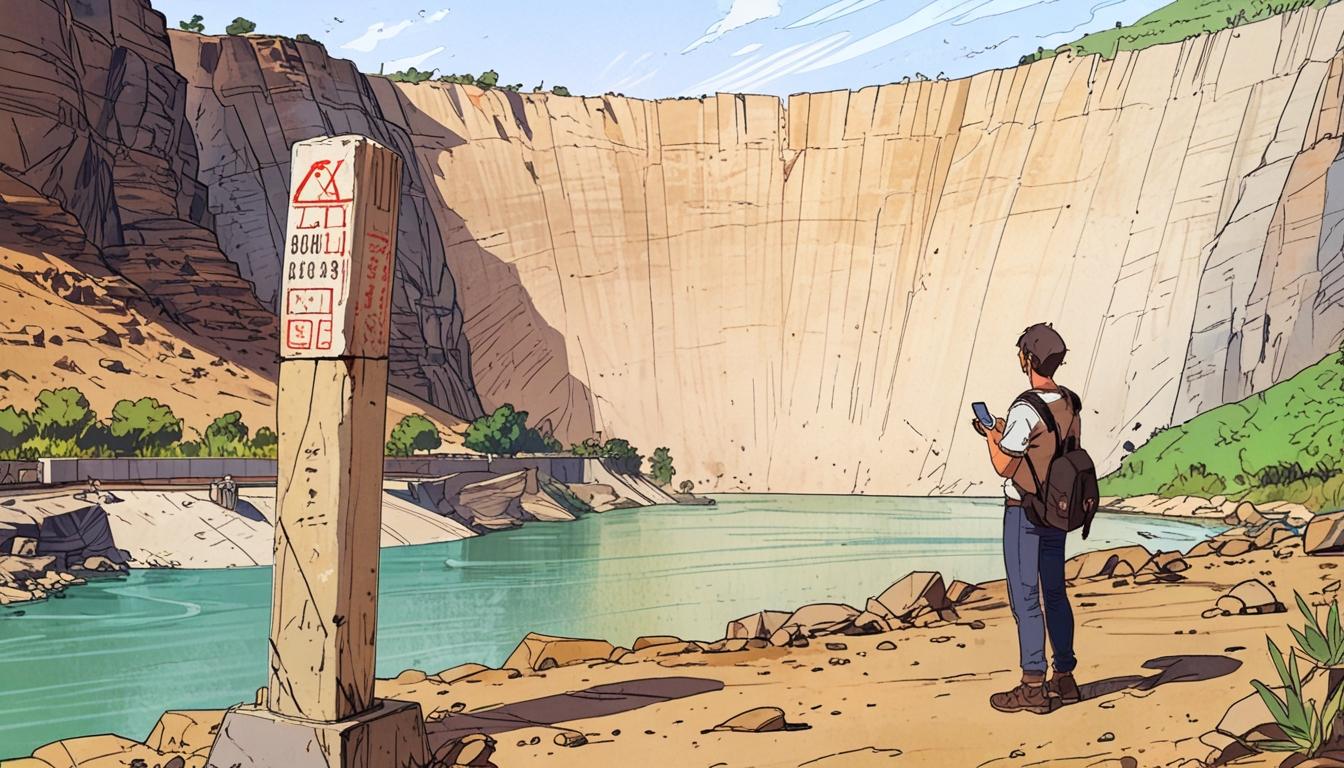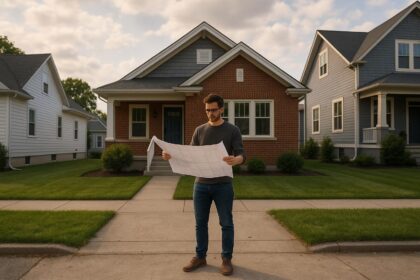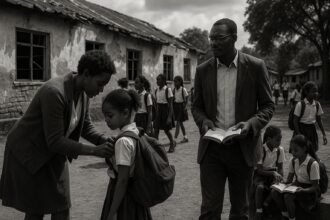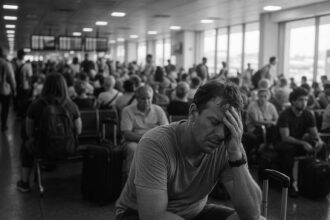As Lesotho prepares to build a dam that will flood the Makhaleng River gorge and displace entire communities, locals like Joel Ralits’a balance traditional farming with smartphone-enabled advocacy amid opaque government plans and rising climate challenges.
Joel Ralits’a’s life in the highlands near Malealea village in Lesotho straddles the divide between traditional livelihoods and modern challenges. At 30 years old, Ralits’a, whose family has farmed maize and sorghum on inherited land for generations, balances his daily work with occasional gigs as a tour guide, showing visitors to a nearby lodge the region’s rock paintings and waterfalls. His fields, hand-tilled and rooted in customary practice, lie near the Makhaleng River gorge, a site soon to face dramatic change.
A freshly poured concrete block dated September 30, 2023, rests at the edge of a steep drop into the gorge, marking the future site of a dam wall the local community has long anticipated. If plans by the Lesotho government and the Orange-Senqu River Commission proceed, the dam will flood the gorge, forcing Ralits’a, his ageing parents, and the entire village to relocate. Details about the timing, compensation, and relocation sites remain unclear, and villagers have had little direct consultation with authorities. Ralits’a uses his smartphone—a vital link to information and democratic engagement despite the area’s remoteness—to try to understand and influence the unfolding situation.
The dam project is part of a broader national strategy, as Lesotho exports water through the Lesotho Highlands Water Project (LHWP), which generates about 10% of the country’s gross domestic product by selling water to Southern African Development Community (SADC) countries. These countries face growing water scarcity exacerbated by climate change, including severe drought episodes like that from 2015 to 2021. However, questions remain about how much benefit reaches local communities, particularly those displaced by such developments. Social scientist Dr Teboho Mosuoe-Tsietsi, who studied communities moved for the LHWP’s Mohale Dam expansion, underlines the need for “exhaustive measures of accountability” to protect affected families from the negative impacts of forced relocations.
In this climate and economic context, a continent-wide survey by Afrobarometer reveals that Africans widely expect their governments to lead climate action, rather than placing primary responsibility on historically high-emitting countries or industries outside Africa. Dr Nick Simpson of the University of Cape Town notes a gap in climate literacy but also an opportunity to increase public engagement. His research finds that access to modern media—smartphones, social media platforms, and internet connectivity—correlates with greater awareness of the roles of global polluters and industries in climate responsibility. This growing awareness may encourage African governments to better respond to citizens’ expectations, particularly in international climate negotiations focused on securing financial support for adaptation and loss and damage.
Despite infrastructure challenges—such as poor roads requiring a donkey cart to reach medical facilities—technology provides a vital channel of information. For Ralits’a and his community, the smartphone offers a measure of agency, allowing them to stay informed and potentially advocate for themselves amid uncertainty.
The Lesotho dam project, part of ongoing efforts to address water scarcity and generate income, thus represents a crossroads for local communities and national development. The prospective flooding of the Makhaleng River gorge will displace families rooted in their land for generations, disrupting social networks and traditional ways of life. While consultation processes and compensation details remain opaque, affected villagers rely on connectivity and information to navigate an uncertain future. The situation highlights complex intersections between climate change, development, governance, and social equity in Lesotho and the broader southern African region.
Source: Noah Wire Services
- https://newsdayonline.co.ls/early-meaningful-consultations-with-communities-are-a-crucial-part-of-designing-highlands-water-projects-lhda/ – This article discusses the Lesotho Highlands Development Authority’s (LHDA) emphasis on early, meaningful consultations with communities to ensure the success of Phase II of the Lesotho Highlands Water Project (LHWP).
- https://pambazuka.org/land-environment/lesotho-highlands-water-project-dam-fine-mess – This piece highlights the insufficient consultation and compensation provided to communities displaced by the LHWP, leading to significant challenges for those affected.
- https://www.seinoli.org.ls/can-anyone-hear-the-socioeconomic-and-environmental-alarm-bells-on-lesotho-highlands-water-project/ – This article examines the socioeconomic and environmental concerns arising from the LHWP, including inadequate compensation and the loss of arable land for local communities.
- https://www.waterpowermagazine.com/analysis/lesotho-highlands-water-project-transforms-local-communities/ – This analysis details the LHDA’s initiatives to empower local communities affected by Phase II of the LHWP, such as skills testing and community-based tourism training programs.
- https://www.afrobarometer.org/publication/ad717-with-climate-change-making-life-worse-africans-expect-governments-and-other-stakeholders-to-step-up/ – This report presents findings from an Afrobarometer survey indicating that Africans expect their governments to take the lead in addressing climate change, rather than placing primary responsibility on historically high-emitting countries or industries outside Africa.
- https://issafrica.org/topics/environmental-security-and-climate-change/01-sep-2008-environmental-change-and-human-security-in-lesotho-the-role-of-the-lesotho-highlands-water-project-in-environmental-degradation-oscar-g – This article discusses the environmental degradation caused by the LHWP, including the loss of fertile land and its impact on food security for local communities.
- https://news.google.com/rss/articles/CBMiuAFBVV95cUxNZ2VDazlEbU9mQTZNdHpUR3FSd2psTTVGRWk5OUNnTEdUYlFvNXh1UllmREFOd0dieEVYdVFldC0wZ1d1LV9YSlg4UEJmZTZPYXRQR2FOcUlNbDl4R2FrRDhadEJHazl2cXl0bE9sRTgtYldzWkllbEpDYnNfMnNOUjBpSlBsbVI5LUNKbEdoZkFERGttOGRNVlRQQWtrOFJjYnpaNVlMUk9rS1dHalEwM3l2T3BtRld3?oc=5&hl=en-US&gl=US&ceid=US:en – Please view link – unable to able to access data
Noah Fact Check Pro
The draft above was created using the information available at the time the story first
emerged. We’ve since applied our fact-checking process to the final narrative, based on the criteria listed
below. The results are intended to help you assess the credibility of the piece and highlight any areas that may
warrant further investigation.
Freshness check
Score:
6
Notes:
The article references a concrete block dated September 2023, indicating some recency. However, lack of explicit publication date and reliance on undated contextual references (e.g., Afrobarometer survey) limit freshness verification.
Quotes check
Score:
8
Notes:
Direct quotes from Dr Teboho Mosuoe-Tsietsi and Dr Nick Simpson lack verifiable timestamps but align with known academic discourse. No evidence of recycled wording from easily accessible prior publications.
Source reliability
Score:
5
Notes:
Narrative originates via Google News but lacks clear attribution to a verifiable publisher. Claims align thematically with reports from bodies like the Orange-Senqu River Commission, though direct sourcing is unclear.
Plausability check
Score:
7
Notes:
Dam projects under the LHWP are well-documented in Lesotho. Climate-linked displacement risks and smartphone-driven engagement trends align with peer-reviewed research on African development, though specific relocation details remain unverified.
Overall assessment
Verdict (FAIL, OPEN, PASS): OPEN
Confidence (LOW, MEDIUM, HIGH): MEDIUM
Summary:
The narrative reflects plausible dynamics of climate adaptation and displacement in Lesotho, supported by contextual alignment with regional development patterns. Key limitations include unspecified publication timeliness and unclear primary sourcing, necessitating further verification of dam project timelines and compensation claims.













